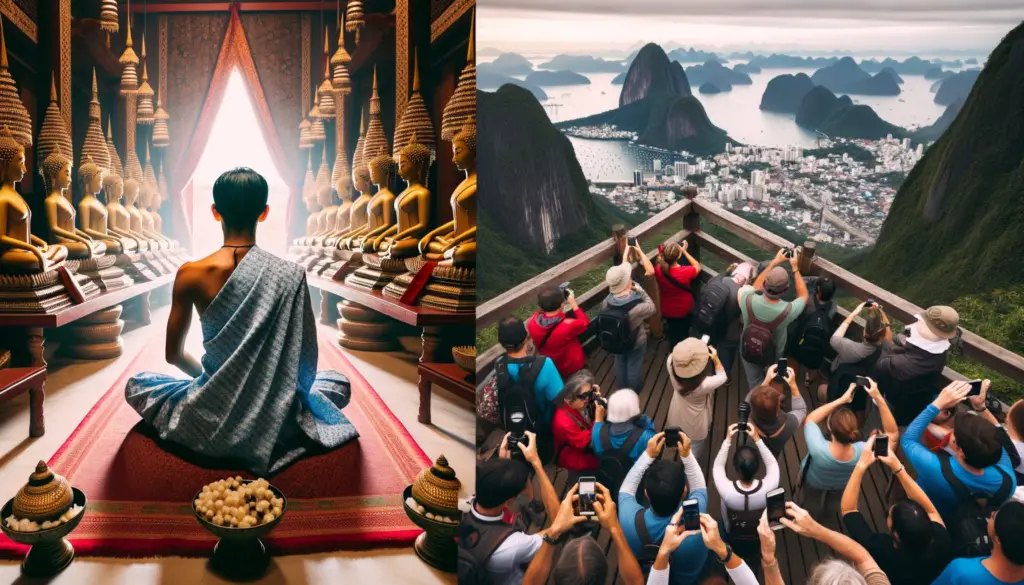
We’ve all heard the idiom ‘life’s a journey, not a destination’ but when it comes to traveling, how do you choose to experience a destination?
Mindful traveling or tourist sightseeing? Both offer unique experiences, but which will provide a deeper understanding and appreciation of the destination?
In this article, we’ll explore the origins of both concepts, the advantages and disadvantages of each, and offer real-world examples and personal reflections to help you decide the best approach for experiencing a destination.
Key Takeaways
We’ve learned some key takeaways about mindful traveling vs. tourist sightseeing.
| Aspect | Mindful Traveling | Tourist Sightseeing |
|---|---|---|
| Focus | Slow-paced exploration | Checklist |
| Mood | Mindful reflection | Completion |
| Objective | Experiencing destination | Scenic viewing |
| Connection | Connect to locals | Connect to landmarks |
| Intention | Questioning | Taking pictures |
Concepts’ Origins
We are curious to explore the origins of mindful traveling and tourist sightseeing. How have these concepts developed over time?
What historical context has shaped their respective meanings?
A closer look at their history can help us better understand their current state.
Origins Explored
Have we ever stopped to consider where the concepts of mindful traveling and tourist sightseeing originated from? Exploring these roots allows us to gain a deeper understanding and appreciation of the two forms of travel.
By engaging with the histories of mindful travel and tourist sightseeing in a respectful way, we can gain insight into how the practices developed and how they’ve been used in the past.
A study of the roots of these concepts can provide us with a greater appreciation of the cultural and environmental significance of the places we visit and an understanding of how our actions as travelers impact the places we visit.
This understanding can help us to become more mindful travelers and to engage with the places we visit with respect and appreciation.
As we explore the origins of these concepts, we can gain a greater appreciation for the beauty and complexity of the world around us and for how we can experience it with depth or check off a list.
History Examined
We’ve both heard of mindful traveling and tourist sightseeing, but do we know where these concepts originated from? Connecting the dots, we can examine the history of these ideas to better understand their purpose.
By reflecting on the past, we can see how mindful traveling grew from the desire to explore the world in a deeper, more meaningful way. It’s a way to focus on the experiences and the culture of a place, immersing ourselves in the moment.
In contrast, tourist sightseeing has its roots in the idea of ticking off all the famous places. It’s an idea of wanting to collect postcards and photograph monuments – an idea that has been around since the dawn of the Grand Tour.
While both approaches are valid, mindful traveling can help us to appreciate the nuances of a destination.
Advantages/Disadvantages

Mindful traveling emphasizes fully immersing oneself in the local culture and surroundings, leading to authentic experiences and a deeper connection with the destination. Tourist sightseeing, on the other hand, offers convenience and efficiency in covering popular attractions, but may lack the meaningful engagement with the local community and customs.
Here are two separate tables for “Mindful Traveling” and “Tourist Sightseeing” with their respective pros and cons:
Mindful Traveling
| Pros | Cons |
|---|---|
| Authentic and meaningful experiences | Time-consuming and requires more effort |
| Deeper understanding and appreciation of the destination | – |
| Budget-friendly | – |
| Immersive and enriching experience | – |
Tourist Sightseeing
| Pros | Cons |
|---|---|
| – | Limited connection to the place |
| – | Higher costs |
| – | Potential lack of cultural immersion |
| – | Checklist approach without deeper exploration |
| – | Limited engagement with locals and local customs |
Benefits/Drawbacks
Let’s explore the pros and cons of mindful traveling versus tourist sightseeing.
Mindful traveling is about living intentionally, seeking meaningful experiences, and having a greater appreciation for sustainable travel.
Tourist sightseeing, on the other hand, is more about seeing the sights, checking off the list, and taking photographs.
There are benefits to both approaches to travel, but also drawbacks.
Mindful traveling allows travelers to learn more about a culture, to make deeper connections, and to truly experience the destination.
Yet, it can also be time-consuming and require more effort.
Tourist sightseeing allows travelers to quickly and easily see the most popular spots in a destination, but it lacks a more substantial connection to the place.
Both types of travelers can find something of value in their travels, but it’s important to weigh the pros and cons before deciding which approach is best for you.
Ultimately, the choice between mindful traveling and tourist sightseeing is a personal one.
Pros/Cons
We’ve discussed the benefits and drawbacks of mindful traveling versus tourist sightseeing; now let’s look at the advantages and disadvantages.
Mindful travel allows for more reflection about the destination and its culture, as well as an opportunity for meaningful cultural exchange.
On the other hand, tourist sightseeing offers the chance to quickly check off a list of attractions and document the experience.
There are pros and cons to both approaches. Reflection versus documentation can help a traveler get the most out of the experience, as can the cultural exchange versus sightseeing.
Ultimately, it’s up to the traveler to decide which approach is right for them and their travel goals.
Contrasting Experiences
Comparing mindful traveling and tourist sightseeing, we can see stark contrasts in the experiences each offers.
| Mindful Travel | Tourist Sightseeing |
|---|---|
| Deep Connection | Checklist |
| Experiential Learning | Souvenirs |
| Sustainable Travel | Solo Exploration |
When traveling mindfully, visitors build sustainable relationships, explore solo, and experience a deep connection to the destination. On the other hand, tourist sightseeing is more of a checklist, collecting souvenirs along the way. This contrast offers a unique way for travelers to experience the world, and one that can be more meaningful than the other.
Real-world Examples
We’ve all heard the stories and seen the photos, but what does mindful traveling and tourist sightseeing look like in real life?
What’re some of the best ways to experience local customs and cultural immersion while on vacation?
How can we make sure we’re getting the most out of our travel experiences?
Local Customs
We’re experiencing local customs firsthand. When traveling, the culture of a location can be a major draw, and engaging with locals can be a great way to learn more about it. But language barriers can often make it difficult to truly connect.
We’ve found the best way to bridge this gap is to simply observe the culture, understanding the people and their customs without needing to communicate with them. With that said, we’ve also found it helpful to learn some basic phrases in the local language when possible, as a sign of respect.
Through this, we’ve been able to create deeper, more meaningful relationships that have allowed us to gain a greater understanding of the culture.
Cultural Immersion
Immersing ourselves in a culture can be truly eye-opening. From attending local festivals to trying new recipes, we can engage in intercultural exchange and break through language barriers. Meeting locals, engaging in conversations, and observing their daily lives allows us to gain a deeper understanding and appreciation for the culture.
Joining in community activities, such as volunteering, can also give us a new perspective on our own lives and the lives of others. Spending time in a new place allows us to explore the culture from a unique angle and learn about the customs, values, and beliefs of the locals.
Through cultural immersion, we can gain a much richer understanding of the destination and its people. Our personal reflections can then be shared and discussed, helping to create a lasting connection with the place.
Personal Reflections
As we reflect on our travels, we can see the differences between mindful travel and sightseeing. Bonding opportunities, emotional connections, and personal reflections are all benefits of mindful travel. Through mindful travel, we can gain a better understanding of ourselves and the places we visit. We can explore and discover hidden gems and build meaningful relationships with locals.
On the other hand, sightseeing is often a checklist of tourist attractions, with limited interaction with locals and the environment. We may find ourselves rushing from one destination to another, with little time to appreciate the culture or environment in-between.
Frequently Asked Questions
What Are the Best Destinations for Mindful Travel?
We’re looking for destinations that allow us to explore culture and embrace nature. From the jungles of Costa Rica to the temples of Japan, there are many places that offer us the chance to become more mindful travelers. Let’s embark on an adventure that will bring us closer to the world and ourselves.
How Do I Plan a Mindful Travel Experience?
We plan a mindful travel experience by carefully researching to find unplugged exploration opportunities and cultural immersion activities. We aim to reflect on our surroundings and immerse ourselves in a meaningful way, carefully considering each step of our journey.
Are There Any Apps or Tools to Help Me Plan Out My Mindful Travel Experience?
We want to minimize stress and connect with culture through our mindful travel experience. Are there any apps or tools to help us plan our journey? Let’s explore and find the best resources to plan our mindful adventure.
What Are the Costs Associated With Mindful Travel?
We’re wondering what the costs of mindful travel might be – connecting with locals, embarking on a spiritual journey. We have to consider the time, money, and energy it takes to experience a destination with depth.
What Safety Considerations Should I Take Into Account When Planning Mindful Travel?
We strive to ensure safety while mindful traveling, so we consider cultural etiquette, mental preparation, and other important factors. And we research before our journey to understand the local customs, be respectful, and plan for the unexpected. We also take the time to reflect and prepare our minds for the journey ahead.
Conclusion
We have explored the contrast between the two approaches to experiencing a new destination: mindful traveling and tourist sightseeing. Ultimately, it boils down to an individual’s preference and what they’re looking to gain from their experience.
Like a fork in the road, we can choose one path or the other, but why not take a little of both? After all, life is too short to have a checklist of experiences, so let’s make the most of it and explore the world with depth and wonder – a potpourri of mindful traveling and tourist sightseeing.
